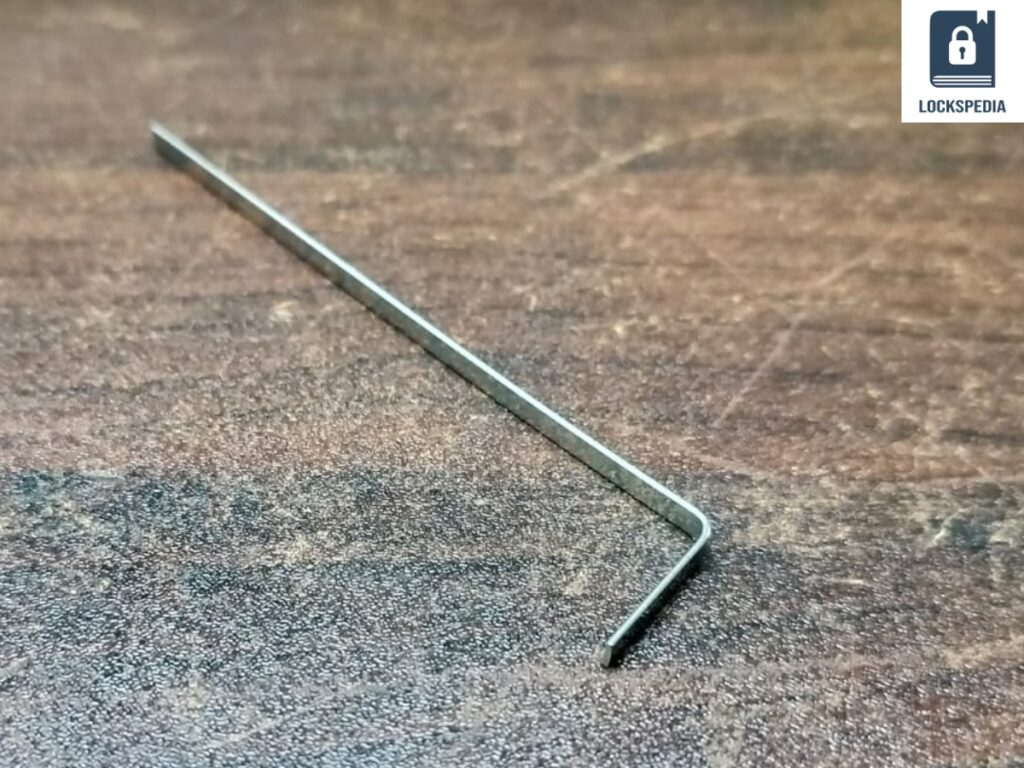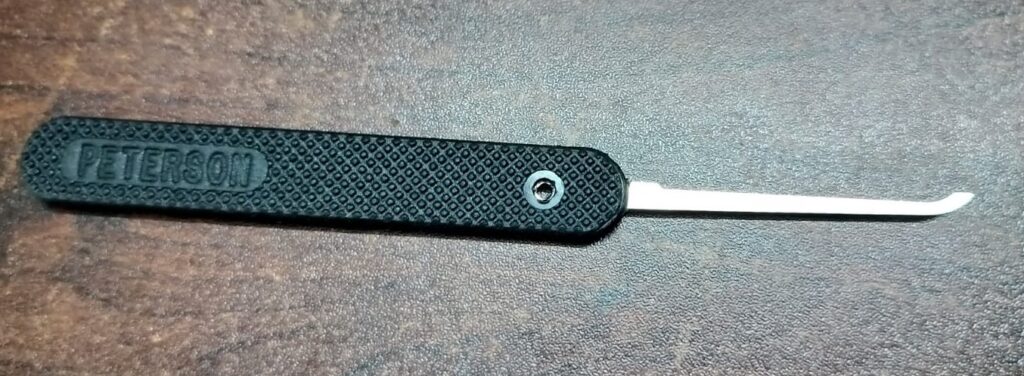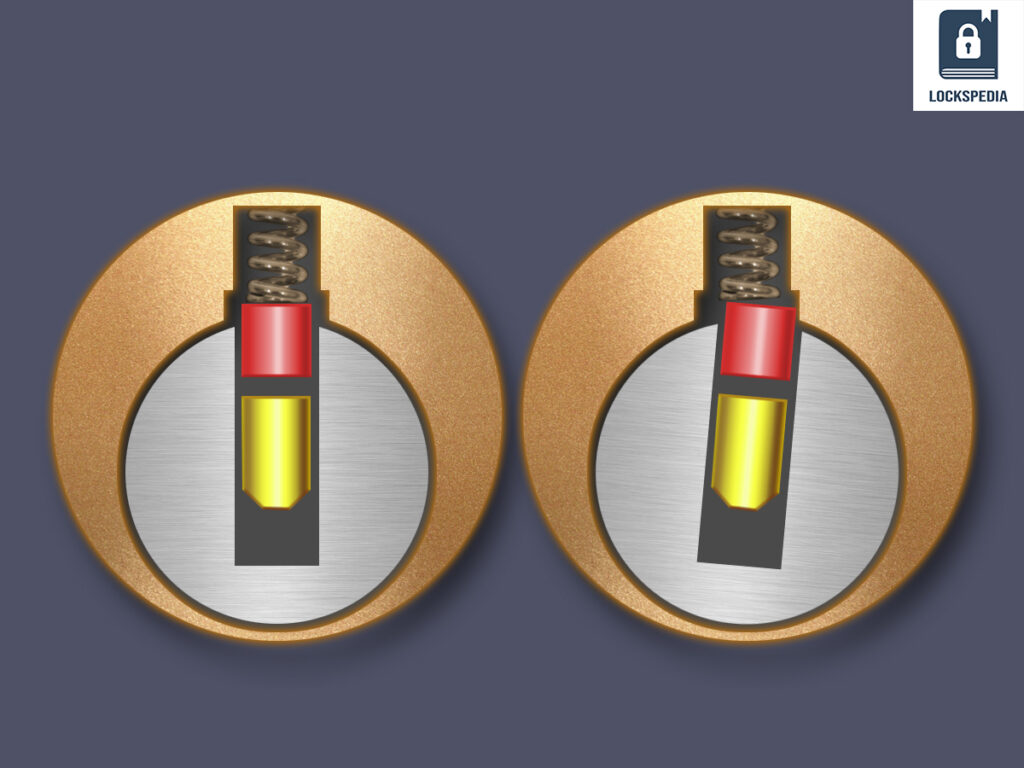Lock picking is not only a great hobby that makes us more focussed and patient but also open our eyes to the illusion of home security. We, the lock pickers, understand how different types of locks work, what are their vulnerabilities and what makes one lock more secure than the other. However, since 90% of all locks are pin tumbler locks, if we understand how to pick them, we would be much wiser regarding our own home security.
So in this comprehensive lockpicking guide, we will delve into 3 different techniques to pick a pin tumbler lock.
- Single Pin Picking
- Raking
- Bumping
We will also explore the advantages and disadvantages of each method. But before we start, let’s do a quick recap of pin tumbler locks first.
Understanding Pin Tumbler Locks
Understanding pin and tumbler locks, including different components and its working, is foundational for grasping how lock-picking techniques functionally manipulate a lock’s inner workings.
Components of a Pin Tumbler Lock
A pin tumbler lock consists of several key components that interact to secure the mechanism:
- Plug: A cylindrical component that turns inside the cylinder to open the lock. This is where we put the key.
- Key Pins: These are the lower set of pins, varying in length, that touch the key when inserted.
- Driver Pins: Located above the key pins, these need to be elevated to align at the shear line to unlock.
- Springs: Positioned above the driver pins, they provide the necessary force to return the pins to their initial position after the key is removed.
- Cylinder: The lock housing that contains plug, pins and springs.
- Shear Line: The dividing line or the gap between the plug and the cylinder; when the pins align on this line, the plug can turn.
- Warding: Grooves cut into the lock to prevent incorrect keys from entering or turning the plug.
The coordination of these components ensures that only the correct key will open the lock.
Mechanism of Action

The mechanism of action for a pin tumbler lock involves a series of actions that occur when a key is inserted and turned:
- Key Insertion: When the correct key slides into the plug, its ridges align with the key pins.
- Pin Alignment: The key raises the key pins and driver pins so they align with the shear line.
- Unlocking: With the pins aligned at the shear line, the cylinder is freed, and the plug can turn, allowing the lock to open.
Understanding the precise alignment and response of these components to the correct key is essential for appreciating the vulnerabilities that lock-picking aims to exploit.
Essential Lock Picking Tools
To effectively pick a pin tumbler lock, there are certain tools that we must have in our kit. These tools are vital for manipulating the lock mechanism and achieving the necessary movement to unlock it.
Tension Wrench

The tension wrench is the cornerstone of our toolset. It’s used to apply torque to the plug of a lock in order to hold the picked pins in place. Without it, the pins would simply drop back down into the plug by spring force. If you don’t have a tension wrench, then you can create your own DIY lock pick tension wrench as well.
Remember, the tension applied must be consistent, and the tension wrench must fit the lock size comfortably. Read this article on common mistakes with tension wrenches in case you get stuck somewhere.
Pick Tools
Under the umbrella of pick tools, there are two main types that we require: the hook pick and the rake.
The hook pick is essential for the single-pin picking technique, allowing us to manipulate each pin individually.

The rake is used for a faster, more brute-force strategy that attempts to set multiple pins at once.

When putting together our collection of picks, it’s crucial to choose ones that are sturdy and well-crafted to withstand the pressures of lock picking.
3 Ways to Pick a Pin Tumbler Lock
We’ll explore three foundational techniques to open a pin and tumbler lock without a key:
- Single Pin Picking
- Raking
- Bumping
Single Pin Picking
With Single Pin Picking (SPP), we focus on manipulating each pin one at a time. This is the best lock picking technique as it helps us in 2 ways –
- SPP works on almost all different kinds of locks even with advanced features like security pins.
- As lock pickers, we learn to understand the feedback mechanism the best from SPP. It makes us better lockpickers.
Follow these steps to unlock a pin tumbler lock without a key –
Applying Tension
We start by inserting a tension wrench either at the bottom or top of the keyway. Choosing between BOK or TOK is more of a personal preference than science. But yes, there are some advantages of TOK over BOK like more space in the keyway which becomes essential when picking a small lock with tiny keyway.
Once the tension wrench is inserted, apply a slight turning pressure to the lock’s plug, simulating the action of turning a key. You will discover that the plug rotates a bit and then gets stuck. This happens due to the binded pin which brings us to the principle of binding order – the most important element in single pin picking.
Binding Order
When we apply a rotational torque to a lock , the plug rotates a bit and then get stuck because a particular pin is trapped between the plug and the housing which restricts further movement of the plug.

So we need to set this single trapped pin to the sheer line, hence the name single pin picking. Once this pin is lifted to the sheer line (set), the plug rotates a few millimeters and another pin gets trapped and so on.
The order in which these pins get trapped between the plug and the cylinder is called the binding order. It should be easy to understand now why pins need to be picked in binding order only. Therefore the entire lock picking skills comes down to identifying the binding order.
Identifying & Setting the Binding Pin
So we’ve understood how important is binding order in the whole scheme of things. Let’s learn now how to identify the binding pin and set it to the sheer line.
- Identify the binding pin: Keeping that light tension on the lock, insert your lock pick (hook) in the keyway and start feeling the pins. If you are using a BOK tensioning tool, I recommend start from the last pin and feel if it provides any resistance. Does it feel stiffer than rest of the pins? If yes, then many congratulations – you’ve just found your binding pin. If not, then move forward to the next pin.
- Setting the binding pin: Once the binding pin is identified, next task is to lift it to the sheer line with the hook pick. This will require patience if you are just starting out but when it happens, you will hear a click sound.
Repeat for Every Pin
Once a binding pin is set to the sheer line, you will feel that the plug has rotated a few more millimeters and another pin gets trapped.
Repeat the same process until and unless all the pins are aligned with the sheer line and the plug is free to rotate fully. Once this is done, just turn the tension wrench to open the lock.
Note: During the entire single pin picking process, applying constant tension on the lock is super important otherwise the pins will fall back to their original position under the spring force.
Raking
Raking is a faster lock picking technique whose aim is to set as many pins to the sheer line as possible in the shortest amount of time. It is less precise than SPP and will not work with locks with advanced security features like sidebars and security pins.
There are various types of rakes available in the market. Choosing the right rake is a topic of another article but we can start with a bogota rake.
Follow these steps to learn how to rake a pin tumbler lock –
Applying Tension
Insert the short end of the tension wrench at the bottom of the keyway and apply light tension. This will create a binding pin.
Insert Rake Lock Pick and Start Brushing
Next step is to insert your rake lock pick in the keyway. Ensure that the rake reaches to the last pin in the stack.
Now just like you brush your teeth, start brushing the pins with the rake. This will involve in-out and up-down movement as shown in the animation below. The idea is to set as many pins as possible to the sheer line.
The success of raking a lock depends on many factors like tension applied, speed, angle of the lock pick etc. So if you are not able to open the lock, don’t lose heart and hope.
Start by playing with the tension. Apply a little bit more tension to ensure that you’ve indeed created a binding pin. Next work on speed and then the angle of the lock pick.
With constant practice, you should be able to rake a pin tumbler lock in less than 45-60 seconds.
Bumping
Bumping is a lock picking technique that uses a bump key or 999 key to bump the lock pins to the sheer line by brute force.
A bump key is a specially designed key with all the cuts made to be maximum depth. Here is how a bump key looks like –

If you remember your childhood, I am sure you would have noticed a nearby locksmith carrying a bunch of them. Yep! these are those keys.
However once used by locksmiths, bump keys have made their way into the hands of burglars as well and have become a trend these days.
Bumping a Pin Tumbler Lock
The working principle of bumping a lock involves inserting a bump key into the keyway just enough to leave one notch short of full insertion. Then using a hammer, the key is struck. The force is transmitted by key pins to the driver pins lifting them to sheer line momentarily freeing the plug to rotate. It is during this brief moment, if the plug is rotated, the lock will open.
There are a couple of points worth remembering when bumping a lock –
- The driver pins will fall back to their original position after the initial jump with spring force. So the window to rotate the plug is short.
- Bump keys are manufacturer’s specific i.e. Kwikset bump key will open only Kwikset locks and likewise. That’s why people keep a set of these keys like this one.
Note: Though I have bumped quite a few locks myself, but I don’t practice and preach this style of lock picking. It takes away all the nuances of lock picking and make me feel like a burglar rather than a hobbyist.
Practice, Practice & Practice
I can’t stress enough on the role of continuous practice if we want to master the art of picking a pin and tumbler lock. Besides the invested time, there are 2 other main factors that will aid you in your journey.
Using Practice Locks
Always begin with clear or cutaway locks. They will allow you to see the inner workings (like pin movement) as you manipulate the pins. This visual feedback accelerates our understanding of the mechanics.
As we progress, we switch to standard practice locks to mimic real-world conditions more closely. Here is a list of the locks that I recommend. Our skill set expands as we practice with a variety of locks, each with different pin configurations.
Improving Tactile Feedback
Tactile feedback is the cornerstone of lock picking—it’s how we “listen” to the lock. To enhance this, we start with gentle tension and gradually increase it until we can identify the subtle differences as each pin sets. Tactile feedback will help you to navigate through issues like oversetting and undersetting pins and advance features like security pins or sidebars.
Just keep in mind that constant repetition and patience is key; through it, we train our fingers to detect minute changes within the lock.
Ethical Considerations of Lock Picking
When we discuss lock picking, it’s essential to address the ethical implications that accompany this skill. I have done an extensive article on legal status of lock picking here. Lock picking, in itself, is not illegal; however, its application can cross legal and moral boundaries.
Legal Aspects:
- Ownership: We must only pick locks that we own, or have been given explicit permission by the owner to pick.
- Intent: We should never use these skills for malicious intent such as burglary or vandalism.
Respect for Privacy:
- We have to respect individuals’ privacy and personal space, refraining from using lock picking to invade or compromise it.
| Consideration | Detail |
|---|---|
| Consent | Obtain permission before picking a lock not owned by you. |
| Privacy | Do not invade someone’s space without their explicit consent. |
| Integrity | Use the skill responsibly and ethically. |
Educational Purpose: Lock picking should primarily be approached as a hobby or for educational purposes. It can be a useful skill for ethical lock sport or professional locksmithing.
Frequently Asked Questions
What are the essential tools needed for picking pin tumbler locks?
For picking pin tumbler locks, we need tension wrenches and pick tools such as a hook or a rake. These instruments allow us to manipulate the pins and apply the necessary tension to turn the lock cylinder.
What is the basic technique for picking a padlock?
The basic technique involves inserting a tension wrench to apply torque and using a pick to set each pin until it aligns at the shear line. When all pins are set at the correct height, the lock will turn open.
Is it possible to pick a pin tumbler lock without any tools, and if so, how?
Yes, it is possible to pick a pin tumbler lock without any tools but require some level of expertise. We can create a tension wrench and lock picks with common household items like paperclip, windshield wiper blade and bobby pin and then pick the lock.
What steps should be taken to pick a standard door lock?
To pick a standard door lock, we insert the tension wrench and apply slight pressure in the direction the key would turn. Then with a pick, we gently lift each pin and search for the binding pin, which we set first, repeating this process until the lock turns.
